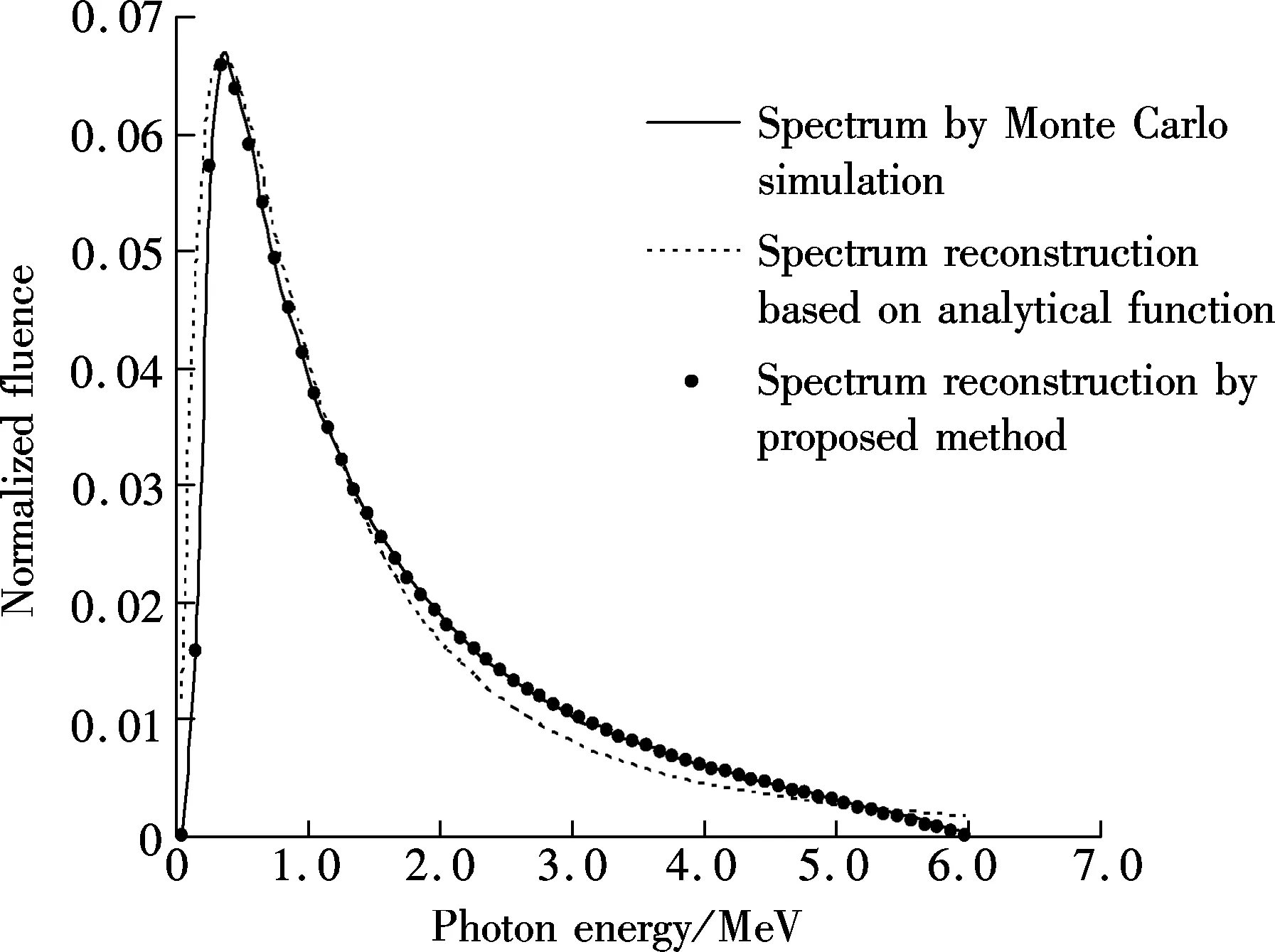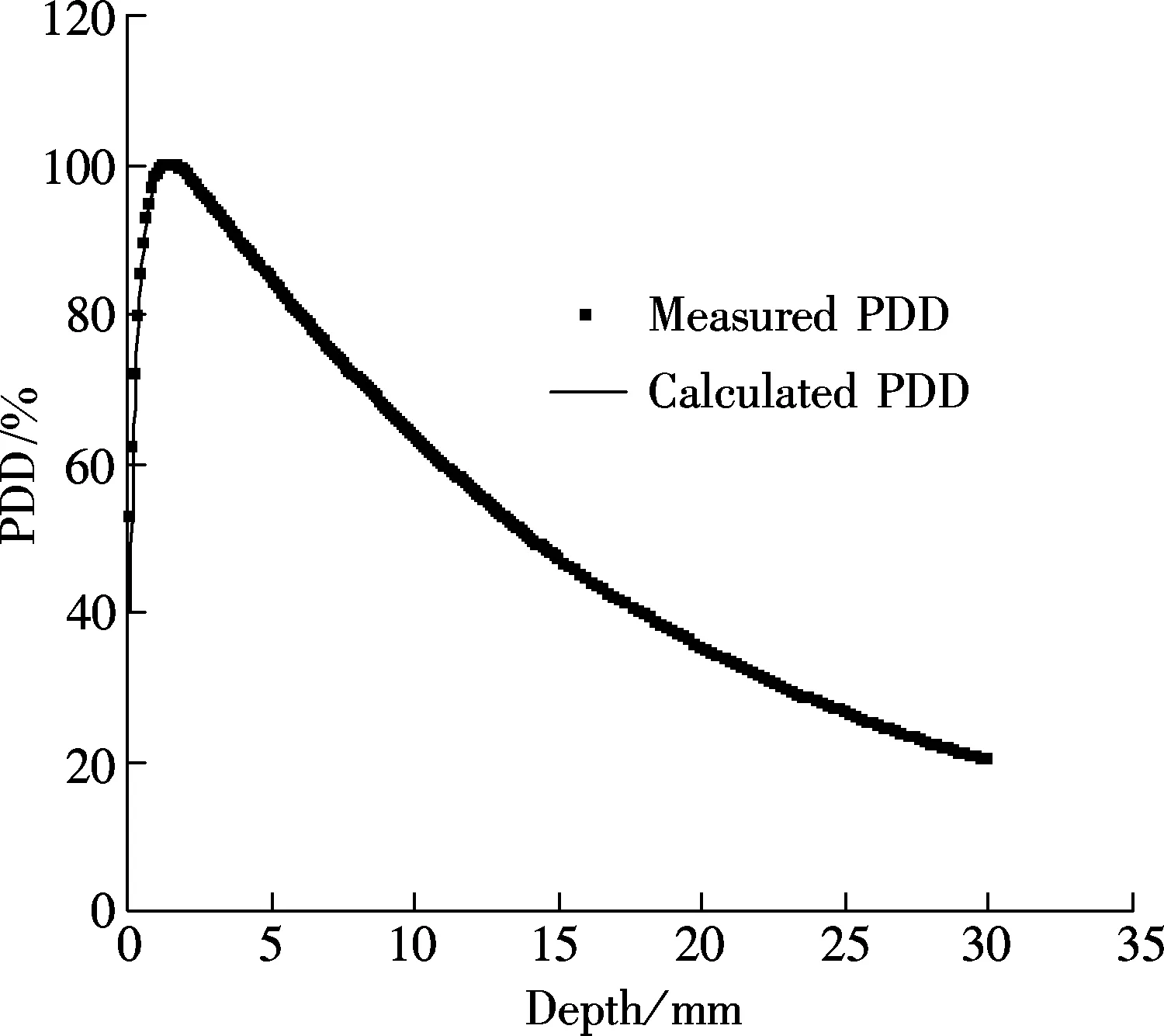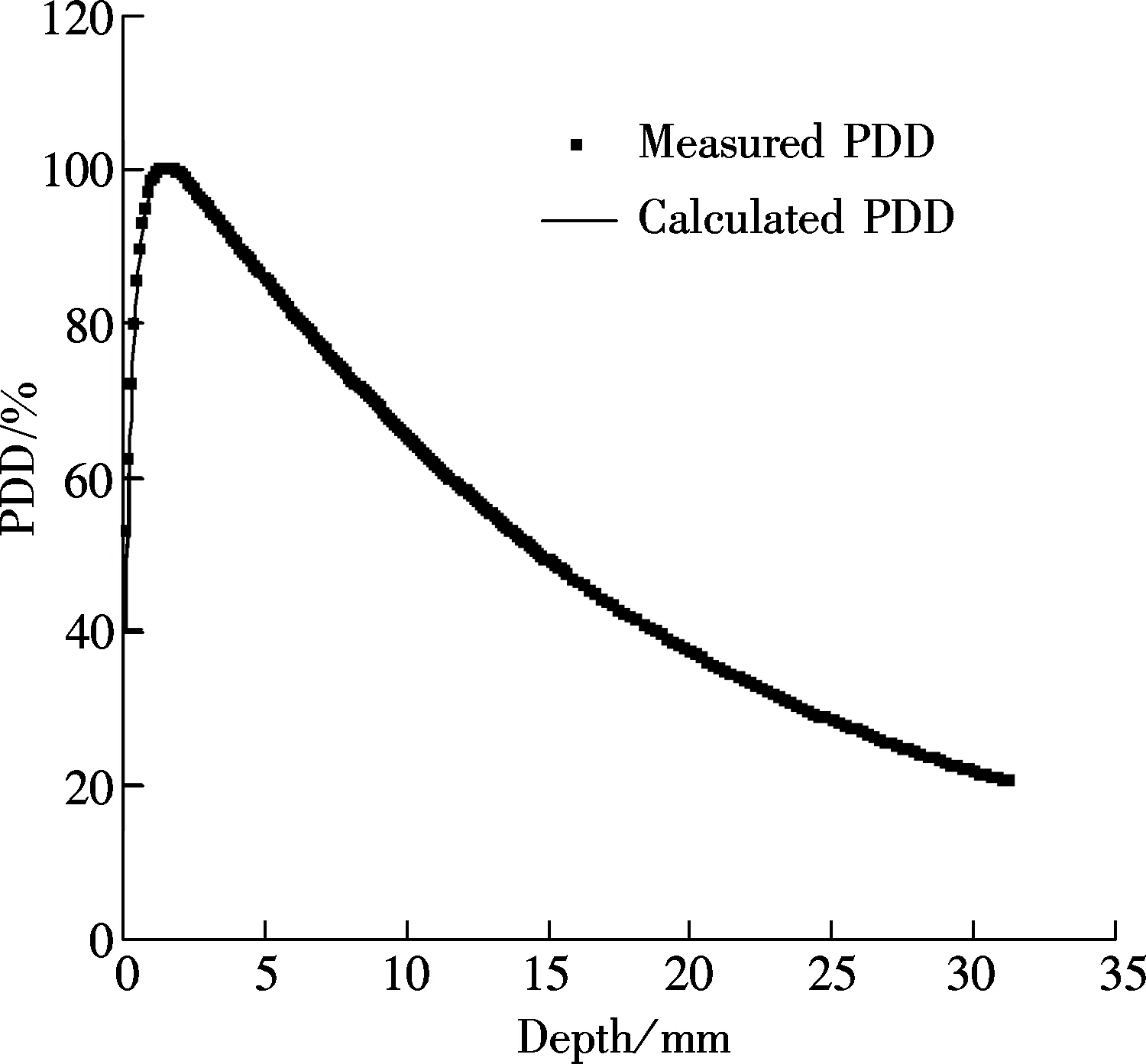Reconstruction of the linac photon spectrum based on prior knowledge and the genetic algorithm
Zhou Zhengdong Chen Yuanhua Wang Dongdong Yu Zili
(Department of Nuclear Science and Engineering, Nanjing University of Aeronautics and Astronautics, Nanjing 210016, China)
Reconstruction of the linac photon spectrum based on prior knowledge and the genetic algorithm
Zhou Zhengdong Chen Yuanhua Wang Dongdong Yu Zili
(Department of Nuclear Science and Engineering, Nanjing University of Aeronautics and Astronautics, Nanjing 210016, China)
In order to derive the linac photon spectrum accurately, both the prior constrained model and the genetic algorithm (GA) are employed using the measured percentage depth dose (PDD) data and the Monte Carlo simulated monoenergetic PDDs, where two steps are involved. First, the spectrum is modeled as a prior analytical function with two parametersαandEpoptimized with the GA. Secondly, the linac photon spectrum is modeled as a discretization constrained model optimized with the GA. The solved analytical function in the first step is used to generate initial solutions for the GA’s first run in this step. The method is applied to the Varian iX linear accelerator to derive the energy spectra of its 6 and 15 MV photon beams. The experimental results show that both the reconstructed spectrums and the derived PDDs with the proposed method are in good agreement with those calculated using the Monte Carlo simulation.
reconstruction of the photon spectrum; prior knowledge; genetic algorithm(GA); percent depth dose (PDD); Monte Carlo simulation
Precise photon spectra are important in radiotherapy such as dose calculation, delivery of treatment plans and in designs of beam regulating devices. However, due to their high energy, the photon beams from the treatment heads of medical electronic accelerators are difficult to measure directly. To solve this problem, several indirect methods have been proposed to determine the photon spectra. The three prominent indirect techniques include the Monte Carlo simulation of treatment heads[1-2], spectral unfolding from depth-dose measurements[3-8]or from experimental transmission data[9-12]. All of the above methods have advantages and disadvantages[5]. Spectral unfolding from depth-dose measurements has the advantage of using clinical beam parameters to ensure that the constructed spectrum will produce the proper depth dose in regions of charged particle equilibrium (CPE).Bloch et al.[5]employed the Cimmino algorithm to determine the energy spectra of clinical photon beams. They demonstrated that the Cimmino algorithm with a small margin, gives an accurate as well as a physically meaningful spectrum, but the margin should be determined carefully to avoid fluctuation of the unfolded spectrum. The margin was found to be between 0.9% and 1.6% for satisfied spectra unfolding in their experiments. In Ref.[13], we proposed a method to derive linac photon spectra based on the generate algorithm (GA); however, the performance of the GA depends much on the initial solution, and it is not easy to achieve the convergence.
In this paper, an alternative method by employing prior knowledge and the GA is investigated for the reconstruction of the linac photon spectra from the photon beam central axis percentage depth dose (PDD) data. Prior knowledge of spectra can be represented as a function with a few free parameters as well as some constrained conditions, making the unfolded spectrum physically meaningful without fluctuation.
1 Methods and Materials
1.1 PDD measurement
With a 5 cm×5 cm field and a 100 cm source surface distance (SSD), the PDDs for 6 and 15 MV photon beams from Varian iX linac were measured in a water phantom (Blue Phantom 2,IBA). From top to bottom, a total of 225 voxels were measured, every 1 mm for depths from 1 to 150 mm, and every 2 mm for depths between 150 and 300 mm, and the measured results were expressed as a vectorD. The small field size was selected both to minimize the contribution of contaminating electrons and to achieve lateral charged particle equilibrium for the photon beam energies used clinically[5].
1.2 PDD simulation of monoenergetic photon beam
Monte Carlo simulations were performed for monoenergetic photon beams utilizing a photon point source located at 100 cm SSD with a 5 cm×5 cm field, where the depth dose was evaluated atI=225 depths, every 1 mm for depths from 1 to 150 mm, and every 2 mm for depths between 150 and 300 mm. The energy deposition on the central ray was tallied in cylindrical voxels of 1 mm in thickness and of 15 mm in radius. The energy range is from 0 to 20 MeV, with an interval bin of 0.1 MeV from 0 to 15 MeV, and 0.5 MeV from 15 to 20 MeV, resulting in the totalJ=160 energy bins. EGSnrc (Electron Gamma Shower, National Research Council of Canada) was used for the Monte Carlo simulation of monoenergetic photon PDDs, where the electron cutoff energy (ECUT) and photon cutoff energy (PCUT) were set to be 0.7 and 0.01 MeV, respectively. The simulation history was set to be 109, resulting in a statistical uncertainty of less than 0.1%. TheJ=160 monoenergetic photon PDDs obtained from simulations was expressed as a matrixA, whereAijis the PDD value of monoenergetic photon beamEiat voxelj.
1.3 Reconstruction method
The problem of photon energy spectrum reconstruction can be expressed as follows:
AΦ=D
(1)
whereΦ={φ1,φ2,…,φJ}Trepresents the photon energy spectrum, and each element is the weight of the corresponding monoenergetic photon beams.
However, the statistical fluctuations in the Monte Carlo simulation and/or experimental variations in the measurements make the above problem an ill-posed problem. In this paper, by incorporating prior knowledge of the photon spectrum, the above problem is modeled as a discretization constrained optimization problem, which can be solved effectively with the GA. Here, we use Matlab’s gatool to solve this problem.
The GA has been effectively applied in a variety of applications, such as mathematical problems, medical problems and engineering problems. The standard GA generally suggests the use of random solutions as the initial population to maintain its diversity[14]. Recent research has shown that the use of initial solutions generated based on the informed initialization scheme can significantly improve the GA’s performance[15-18].
Considering the linac photon spectra, its prior knowledge can be modeled as some kind of functions with a few number of free parameters[6,19]. In this paper, the following function with two unknown parameters is employed:

(2)
whereEis the photon energy in MeV;Epis the energy at which the peak in the spectrum is located;αis the width of the peak.
Another very important prior knowledge, which can be used to avoid fluctuation in a reconstructed spectrum, can be expressed as follows:
(3)
Thus the reconstruction problem can be defined as the following constrained optimization problem:

(4)
s.t.
whereFrepresents fitness.
Therefore, the reconstruction of photon spectra involves two steps:
1) The unknown two parameters of Eq.(2) are solved with the GA. The solved function at this stage is used to generate initial populations for the GA’s first run in the second optimization step.
2) A further optimization based on the GA is applied to Eq.(4) to obtain more precise spectra.
2 Results and Discussion
For evaluation, we compare the results of the proposed method with those from the Monte Carlo simulation.
The comparison between the energy spectra of 6 and 15 MV photon beams calculated by the Monte Carlo simulation,the analytical function based optimization,and the proposed two-step methods are shown in Figs.1(a) and (b). For energy spectra of 6 and 15MV photon beams calculated using the Monte Carlo simulation and the proposed two steps method, their correlation coefficients are 0.999894% and 0.999946%, respectively.

(a)

(b)
From Figs.1(a) and (b), we can see that the spectrum calculated by analytical function based optimization gives a good approximation of that calculated by the Monte Carlo simulation, and their peaks are almost at the same location. The energy spectra of 6 and 15MV photon beams reconstructed from the proposed two steps method agree very well with that calculated by the Monte Carlo simulation.
The comparison of the PDD calculated from the derived spectrum with the measured PDD for 6 and 15 MV beams is shown in Fig.2. For both 6 and 15 MV beams, the two peaks of PDD curves are located within 1 mm. For 6 and 15 MV beams, the correlation coefficients of PDD are 0.99991 and 0.99993, respectively. From Fig.2, we can see that these PDDs fit very well for both 6 and 15 MV photon beams, except for a few voxels near the phantom surface.
This improved spectrum reconstruction method has two

(a)

(b)
advantages over the GA approach investigated before:
1) The usage of prior knowledge, which leads to a better convergence, guarantees a higher possibility of achieving a physical realistic solution.
2) The prior-knowledge-based initialization for the second step optimization, which is physically close to the realistic spectrum, reduces the optimization space and improves computational efficiency.
3 Conclusion
This study demonstrates that the polyenergetic photon spectrum of linac can be unfolded well from the measured PDD data by employing the genetic algorithm with simulated monoenergetic PDDs and an analytical model of the expected photon spectrum shape. The introduction of both the analytical model and the constrained conditions as a prior knowledge for the spectrum reconstruction can avoid the fluctuation of reconstructed spectrum found in the Cimmino algorithm. The good agreement of spectra and PDDs between the derived results and the Monte Carlo results shows that the proposed method is effective and accurate. Further studies will be carried out to apply this method to other types of medical accelerators used in radiation therapy.
[1]Mohan R, Chui C, Lidofsky L. Energy and angular distributions of photons from medical linear accelerators[J].MedPhys, 1985, 12(5): 592-597.
[2]Sheikh-Bagheri D, Rogers D W O. Monte Carlo calculation of nine megavoltage photon beam spectra using the BEAM code[J].MedPhys, 2002, 29(3):391-402.
[3]Ahnesjö A, Andreo P. Determination of effective bremsstrahlung spectra and electron contamination for photon dose calculations[J].PhysMedBiol, 1989, 34(10):1451-1464.
[4]Sauer O, Neumann M. Reconstruction of high-energy bremsstrahlung spectra by numerical analysis of depth-dose data[J].RadiotherOncol, 1990, 18(1):39-47.
[5]Bloch P, Altschuler M D, Bjarngard B E, et al. Determining clinical photon beam spectra from measured depth dose with the Cimmino algorithm[J].PhysMedBiol, 2000, 45(1):171-183.
[6]Deng J, Jiang S B, Pawlicki T, et al. Derivation of electron and photon energy spectra from electron beam central axis depth dose curves[J].PhysMedBiol, 2001, 46(5):1429-1449.
[7]Paniak L D, Charland P M. Enhanced bremsstrahlung spectrum reconstruction from depth-dose gradients[J].PhysMedBiol, 2005, 50(14):3245-3261.
[8]Ali E S M, McEwen M R, Rogers D W O. Beyond self-consistency in beam commissioning: determination of true linac spectra[J].MedPhys, 2011, 38(6):3870-3871.
[9]Armbruster B, Hamilton R J, Kuehl A K. Spectrum reconstruction from dose measurements as a linear inverse problem[J].PhysMedBiol, 2004, 49(22):5087-5099.
[10]Delgado V. Determination of x-ray spectra from attenuation data by imposing a priori positiveness and bounded support: theory and experimental validation[J].MedPhys, 2007, 34(3):994-1006.
[11]Delgado V. Determination of x-ray spectra from Al attenuation data by imposing a priori physical features of the spectrum: Theory and experimental validation[J].MedPhys, 2009, 36(1):142-148.
[12]Ali E S M, Rogers D W O. An improved physics-based approach for unfolding megavoltage bremsstrahlung spectra using transmission analysis[J].MedPhys, 2012, 39(3):1663-1675.
[13]Zhou Zhengdong, Chen Yuanhua, Liu Juan. Reconstruction method of photon spectra of medical linear accelerator based on genetic algorithm[J].JournalofSoutheastUniversity:NaturalScienceEdition, 2012, 42(6):1085-1088.(in Chinese)
[14]Goldberg D E.Geneticalgorithmsinsearch,optimization,andmachinelearning[M]. New York: Addison-Wesley, 1989.
[15]Togan V, Daloglu A T. An improved genetic algorithm with initial population strategy and self-adaptive member grouping[J].Computers&Structures, 2008, 86(11/12):1204-1218.
[16]Rahnamayan S, Tizhoosh H, Salama M. A novel population initialization method for accelerating evolutionary algorithms[J].Computers&MathematicswithApplications, 2007, 53(10):1605-1614.
[17]Maaranen H, Miettinen K, Penttinen A. On initial populations of a genetic algorithm for continuous optimization problems[J].JournalofGlobOptim, 2007, 37(3):405-436.
[18]Maaranen H, Miettinen K, Mäkelä M M. Quasi-random initial population for genetic algorithms[J].Computers&MathematicswithApplications, 2004, 47(12):1885-1895.
[19]Ali E S M, Rogers D W O. Functional forms for photon spectra of clinical linacs[J].PhysMedBiol, 2012, 57(1):31-50.
基于先验知识和遗传算法的直线加速器光子能谱重建
周正东 陈元华 王东东 余子丽
(南京航空航天大学核科学与工程系, 南京 210016)
为了准确地获得直线加速器的光子能谱,根据测量的百分深度剂量和蒙特卡洛模拟的单能光子百分深度剂量,采用先验约束模型和遗传算法来进行优化求解.首先,将光子能谱建模为一个包含2个参数α和Ep的先验解析函数,采用遗传算法对该模型进行优化求解;然后,将光子能谱建模为一个离散约束优化模型,并利用遗传算法进行优化求解,初始解由第1步获得的解析函数产生.将该方法应用于瓦里安iX直线加速器来计算其6和15MV光子束的能谱,实验结果表明,采用该方法重建获得的光子能谱以及百分深度剂量与蒙特卡洛模拟计算的结果具有良好的一致性.
光子能谱重建;先验知识;遗传算法;百分深度剂量;蒙特卡洛模拟
TP391;R318
:Zhou Zhengdong, Chen Yuanhua, Wang Dongdong, et al. Reconstruction of the linac photon spectrum based on prior knowledge and the genetic algorithm[J].Journal of Southeast University (English Edition),2014,30(3):311-314.
10.3969/j.issn.1003-7985.2014.03.010
10.3969/j.issn.1003-7985.2014.03.010
Received 2013-11-28.
Biography:Zhou Zhengdong(1969—), male, doctor, associate professor, zzd-msc@nuaa.edu.cn.
 Journal of Southeast University(English Edition)2014年3期
Journal of Southeast University(English Edition)2014年3期
- Journal of Southeast University(English Edition)的其它文章
- P-FFT and FG-FFT with real coefficients algorithm for the EFIE
- Compressed sensing estimation of sparse underwateracoustic channels with a large time delay spread
- Improved metrics for evaluating fault detection efficiency of test suite
- Early-stage Internet traffic identification based on packet payload size
- An adaptive generation method for free curve trajectory based on NURBS
- Stability analysis of time-varying systems via parameter-dependent homogeneous Lyapunov functions
